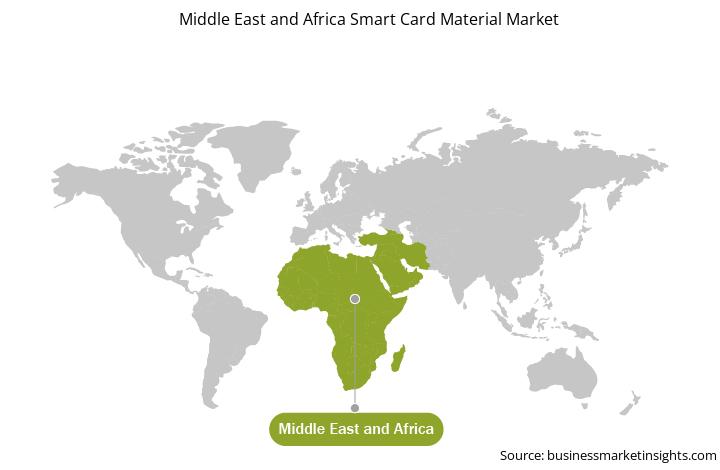中东和非洲智能卡材料市场预测至 2028 年 - COVID-19 影响和按材料(聚氯乙烯 (PVC)、聚碳酸酯 (PC)、丙烯腈丁二烯苯乙烯 (ABS)、聚对苯二甲酸乙二醇酯 (PETG) 等)的区域分析)、类型(接触式卡、非接触式卡和多组件卡)和应用程序(BFSI、政府、电信、零售、医疗保健、酒店等)
No. of Pages: 117 | Report Code: TIPRE00028692 | Category: Chemicals and Materials
No. of Pages: 117 | Report Code: TIPRE00028692 | Category: Chemicals and Materials
人们越来越关注制造智能卡来自更多的可再生资源。该地区的许多公司都致力于开发塑料含量更少的新产品。生物基塑料材料是用于生产智能卡的传统塑料的新兴子集。 LUC-BIO 就是这样一种材料,它是 PVC 的一种绿色形式,旨在满足日益增长的绿色产品需求。 Universal Smart Cards Inc. 使用这种材料生产智能卡。一家主要制造商采用生物基材料制造了射频识别 (RFID) 卡和智能卡。最终用途行业需要由可生物降解材料制成的智能卡,以保持其产品的生态可持续性并遵守国家的指导方针。因此,在预测期内,对生物基材料开发的日益关注将成为智能卡材料市场的趋势。
<在中东和非洲地区,南非是COVID-19确诊病例和死亡人数较高的主要国家之一。 COVID-19 大流行对中东和中东地区的经济产生了严重影响。非洲。由于对各行业增长的负面影响,该流行病已显着减缓了该地区智能卡材料市场的增长。 COVID-19 大流行影响了零售和酒店业。由于封锁和居家令,顾客的足迹减少了。该地区对智能卡材料的需求将取决于疫情的演变、疫苗接种计划和经济复苏。
随着新的功能和技术,供应商可以吸引新客户并扩大他们在新兴市场的足迹。这一因素可能会推动智能卡材料市场的发展。 MEA 智能卡材料市场预计在预测期内将以良好的复合年增长率增长。
Strategic insights for Middle East and Africa Smart Card Material involve closely monitoring industry trends, consumer behaviours, and competitor actions to identify opportunities for growth. By leveraging data analytics, businesses can anticipate market shifts and make informed decisions that align with evolving customer needs. Understanding these dynamics helps companies adjust their strategies proactively, enhance customer engagement, and strengthen their competitive edge. Building strong relationships with stakeholders and staying agile in response to changes ensures long-term success in any market.

| Report Attribute | Details |
|---|---|
| Market size in 2021 | US$ 54.97 Million |
| Market Size by 2028 | US$ 72.44 Million |
| Global CAGR (2021 - 2028) | 4.0% |
| Historical Data | 2019-2020 |
| Forecast period | 2022-2028 |
| Segments Covered |
By 材料
|
| Regions and Countries Covered | 中东和非洲
|
| Market leaders and key company profiles |
The regional scope of Middle East and Africa Smart Card Material refers to the geographical area in which a business operates and competes. Understanding regional nuances, such as local consumer preferences, economic conditions, and regulatory environments, is crucial for tailoring strategies to specific markets. Businesses can expand their reach by identifying underserved regions or adapting their offerings to meet regional demands. A clear regional focus allows for more effective resource allocation, targeted marketing, and better positioning against local competitors, ultimately driving growth in those specific areas.

The Middle East and Africa Smart Card Material Market is valued at US$ 54.97 Million in 2021, it is projected to reach US$ 72.44 Million by 2028.
As per our report Middle East and Africa Smart Card Material Market, the market size is valued at US$ 54.97 Million in 2021, projecting it to reach US$ 72.44 Million by 2028. This translates to a CAGR of approximately 4.0% during the forecast period.
The Middle East and Africa Smart Card Material Market report typically cover these key segments-
The historic period, base year, and forecast period can vary slightly depending on the specific market research report. However, for the Middle East and Africa Smart Card Material Market report:
The Middle East and Africa Smart Card Material Market is populated by several key players, each contributing to its growth and innovation. Some of the major players include:
The Middle East and Africa Smart Card Material Market report is valuable for diverse stakeholders, including:
Essentially, anyone involved in or considering involvement in the Middle East and Africa Smart Card Material Market value chain can benefit from the information contained in a comprehensive market report.